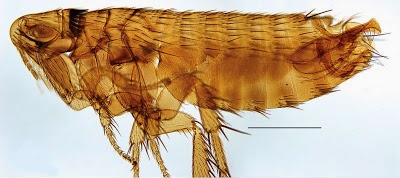The first Mesozoic fossil Fleas were discovered in Cretaceous
deposits in Australia and Russia in the 1970s. However no further Mesozoic
Fleas were reported between 1976 and 2012, since when a number of fossil Fleas
have been reported from the Jurassic and Early Cretaceous of northeastern
China. These Mesozoic Fleas are larger than modern Fleas (with Jurassic Fleas
being larger than Cretaceous Fleas), and are thought to have fed on feathered
Dinosaurs, early Birds, Mammals and Pterosaurs.
In a paper published in the journal BMC Evolutionary Biology on 27
August 2014, Taiping Gao and Chungkun Shih of the College of Life Sciences at
Capital Normal University, Alexandr Rasnitsyn of the Palaeontological Institute
of the Russian Academy of Sciences and the Natural History Museum in London, XingXu of the Key Laboratory of Evolutionary Systematics of Vertebrates at the Instituteof Vertebrate Paleontology and Paleoanthropology of the Chinese Academy ofSciences, Shuo Wang of the Key Laboratory of Evolutionary Systematics of
Vertebrates, and of the Graduate University of the Chinese Academy of Sciences,
and Dong Ren, also of the College of Life Sciences at Capital Normal University
describe a new species of Flea from the Early Cretaceous Yixian Formation of
Liaoning Province, China.
The new species is placed in the genus Pseudopulex, which already contains two species, and given the
specific name tanlan, meaning
‘avaricious’ in Mandarin, due to the fully distended abdomen of the female
specimen, and the voracious feeding this implies. The species is described from
two specimens, a female 9.26 mm in length and a male 9.5 mm in length. Both
specimens come from an exposure of the Yixian Formation at Dawangzhangzi
Village, which has been dated to 124.6 million years old.
Female specimen of Pseudopulex tanlan,
(A) photograph and (B) line drawing. Gao et
al. (2014).
The female specimen of Pseudopulex tanlan
has a notably distended abdomen, which Gao et
al. interpret as a sign that it had fed shortly before its death. The width
of the abdomen is 4.0 mm, equal to 43% of its length, compared to an average of
28% for other described female Mesozoic Fleas. Gao et al. estimate that when not distended the abdomen would only have
been 2.6 mm wide, suggesting that the Insect had ingested about 0.02 ml of
blood, roughly 15 times the amount that modern Fleas typically consume.
Male specimen of Pseudopulex tanlan,
(A) photograph and (B) line drawing. Gao et
al. (2014).
See also…
Hangingflies are long-legged Scorpionflies (Mecoptera), a group of
insects related to the True Flies. Scorpionflies get their name from the
reproductive organs of the males of some species, which resemble the
tails of Scorpions. Despite this fierce appearance most species are
harmless herbivores, though it is thought that fleas are highly...
 A new species of Flea from the Philippines. Fleas of the Family Stivaliidae are found across Africa, Australasia and
Southeast Asia. They are specialist parasites of Rodents and Shrews
(and occasionally...
A new species of Flea from the Philippines. Fleas of the Family Stivaliidae are found across Africa, Australasia and
Southeast Asia. They are specialist parasites of Rodents and Shrews
(and occasionally... Giant Fleas from the Jurassic of China. Fleas are highly specialized parasitic insects, preying on mammals and
birds. They are related to Flies and Scorpionflies, though this
relationship is not obvious as Fleas have become physically specialized,
loosing their wings, altering their body shape and evolving specialized
legs and mouthparts. A number of putative fossil fleas have been
described from the Jurassic...
Giant Fleas from the Jurassic of China. Fleas are highly specialized parasitic insects, preying on mammals and
birds. They are related to Flies and Scorpionflies, though this
relationship is not obvious as Fleas have become physically specialized,
loosing their wings, altering their body shape and evolving specialized
legs and mouthparts. A number of putative fossil fleas have been
described from the Jurassic...
Follow Sciency Thoughts on Facebook.



